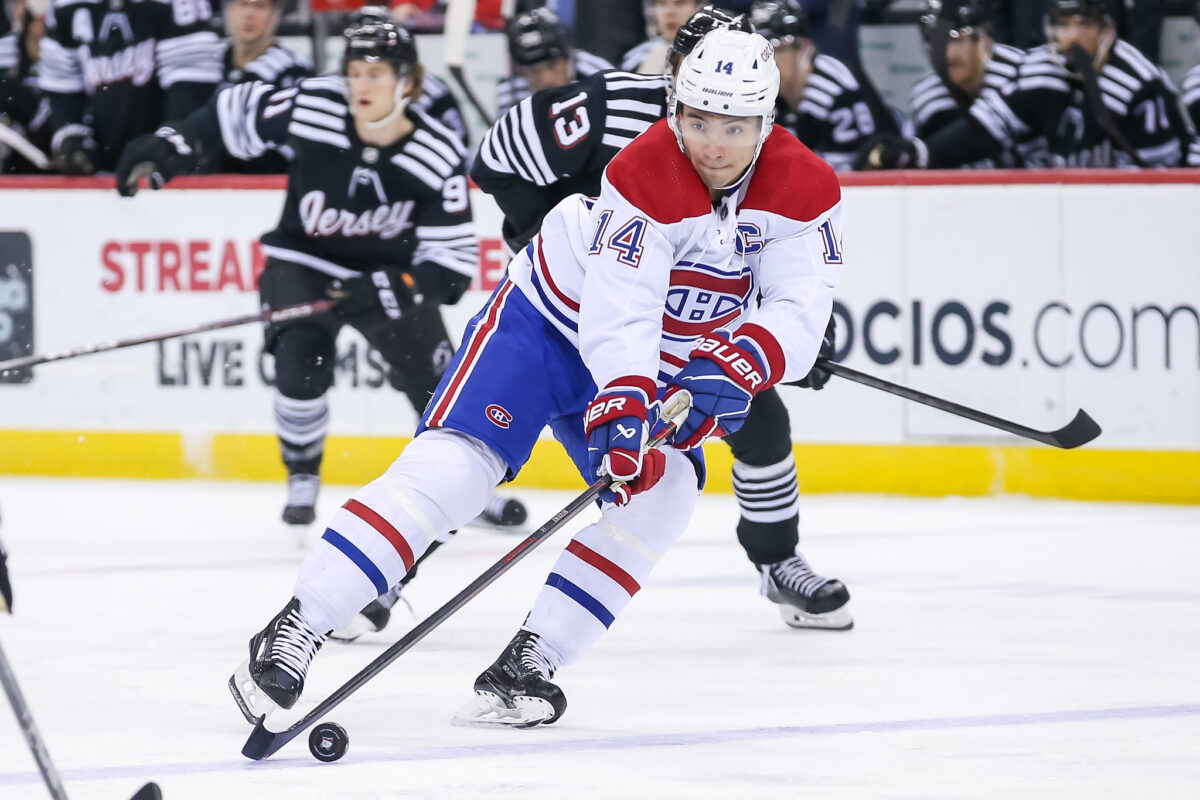The Montreal Canadiens’ rebuild is in its second full season, and it is slowly progressing. The question is, when will they be done? In the rebuild series, the team’s needs and wants were covered in the last installment. This one will look at the Canadiens’ salary cap structure that general manager (GM) Kent Hughes is currently constructing.
Related: Montreal Canadiens Rebuild Almost Complete
This installment will look at the contracts of those in the system, and use cap projections to estimate the cost of the contracts and what space remains. Using the salary cap as a guide, it does look as though the timing of the rebuild’s metamorphosis into a playoff team, possibly even a contender, coincides with the end of some rather large contracts that were inherited from the previous managerial regime.
Canadiens’ Future Salary Cap
The NHL is projecting the salary cap to rise to $87.7 million for 2024-25, and the expectation is for it to increase by another five percent for 2025-26 to $92.1 million. That should be a godsend for a team in a rebuild as they have the cap space to pay their young stars as they complete their entry-level contracts (ELC), right? Well…it’s complicated.
Montreal has only nine players signed into or past the 2025-26 season. This includes the following rostered players – Cole Caufield, Nick Suzuki, Brendan Gallagher, Josh Anderson, Alex Newhook, Kirby Dach, Joshua Roy, Mike Matheson and Samuel Montembeault. With the projected salary cap ceiling of $91.1 million, they’ll have around $49 million to sign a minimum of 11 players. Which sounds amazing. This summer is the easy part, Justin Barron and Arber Xhekaj headline the players that have a future with the Canadiens and require a contract. They are likely looking at modest raises on their ELC deals, nothing more than $3 million for a short-term deal for Xhekaj and half of that for Barron, so this shouldn’t cause the team problems. However, this summer Hughes must decide on what to do with his eight restricted free agents.

Players such as Jordan Harris and Jayden Struble will be the smaller deals to handle. Not that they are insignificant, but they aren’t considered core pieces. They are however significant assets that may be used as trade bait before the summer of 2025 arrives. But if they aren’t, and their progression stays at the current rate, Harris is likely to be able to command $3 to $3.5 million and Struble about half of that. Other names include Cayden Primeau, likely to be an NHL backup at that time, Sean Farrell, and Emil Heineman, all three are likely to be had for $1 million each. But there are two significant pieces, core pieces, that will command Hughes’ attention and a large chunk of the available cap space.
Canadiens Core Players Cost
Juraj Slafkovsky and Kaiden Guhle are those two core players. Guhle is rounding into a top-pair defender. While he isn’t putting up astounding offensive numbers, he is a highly mobile defender who can generate controlled zone exits and entries. He has the size to play a physical style. He is also capable of playing a shutdown role against the NHL’s best forwards thanks to his elite speed.
This points to Guhle receiving a long-term contract and not a bridge deal. If that’s the case, Hughes is buying some of his unrestricted free agent (UFA) years, so the cost goes up. Even if he takes a team-friendly deal, it is going to be around the $6 million mark to get a full eight years.
For Slafkovsky, it will cost more. Like Guhle, Slafkovsky has been showing his value to the club as he rounds out his game in a short period of time. Since being added to the top line, his confidence has grown. He has displayed his high-end playmaking skills, excellent shot, solid defensive play, and his ability to use his size to his advantage in board battles. He has even had a similar growth in his game as some other top picks that are now considered superstars.
Hughes has shown that he is unafraid to skip bridge deals for core players when he signed Caufield to his eight-year contract. This likely means that Slafkovsky will be signed to a max-length deal that would start in 2025-26. Using the Suzuki and Caufield contracts as a baseline is fair, they were both signed to full-term deals right off their ELCs. They’re both top-of-the-lineup players as well. But, with the cap increasing the Slovak forward is likely to get more, but if Hughes keeps it to $8.5 million or less, that’s a victory for him.
Canadiens Cap Calculations
Add up the estimations of all nine players mentioned above and that leaves $21.5 million remaining from the originally estimated $49 million. It seems like a lot remains to sign three players. One of those players Hughes could target is a star UFA. This is where cultivating a team culture could pay off as he could use the world-class facilities, well-known and respected head coach and a team on the rise to try and coax a UFA to sign in Montreal to round out and complement his core, maybe a $10 or $11 million player. Which could be the elite-level player the team needs to complete their roster like Canadiens executive vice president Jeff Gorton had done as the GM of the New York Rangers when he signed Artemi Panarin, jump-starting their status as contenders. If Hughes believes he has the core pieces in place and is lacking this one element, this is a likely scenario.

The other two positions can be filled by adding a middle-six forward and/or a bottom-four defender for around $4 to $5 million each. Now that remaining cap is down to around $5 or $6 million. GMs always want to keep a cushion to make trade deadline deals or to take into account any raises for players that work their way into the roster, like a Joshua Roy. This approach allows for the team to have the depth it would need to support their higher-skilled players with depth scoring and an ability to fill in on specialty teams, especially in case of injury.
Difficult decisions will need to be made concerning a couple of veterans, Gallagher and Anderson. They will be in their last seasons of their deals in 2026-27, costing the club $12 million per year. Anderson and his $5.5 million contract is the easier of the two contracts to deal with as he still has trade value, even after his disastrous 2023-24 campaign. While Hughes may not get the big returns he hoped for, he could move on from the 29-year-old. Gallagher on the other hand is another story, as at $6.5 million, Hughes is stuck with the burden of his contract.
Gallagher is no longer the 30-goal scorer he once was, and he is regressing. He is being paid for what he has done, and not for what value he is expected to provide. He is now firmly in the bottom six, even now on a rebuilding team’s roster, and once this team is ready to compete, will likely be a very expensive fourth-line player. Eventually, Hughes will need to either hope Gallagher retires, or that he can convince another club to take him on. However, that will cost the team assets, something Hughes could afford after the Canadiens have been stockpiling picks and prospects for several years. The additional cap space may be worth it as the goal at that time won’t be to “win trades” it will be to win games, and the newly open cap space could help provide one or even two younger and more productive players.
While the last regime did saddle Hughes with some problematic contracts, the term of most are a fit for the rebuild plan. As a former player agent, he has experience as a tough negotiator who could get fair, or even team-friendly contracts from his best players. The Canadiens’ salary cap window points to a team that has set its budget to be open to keeping its core and have the flexibility to also add to it.
